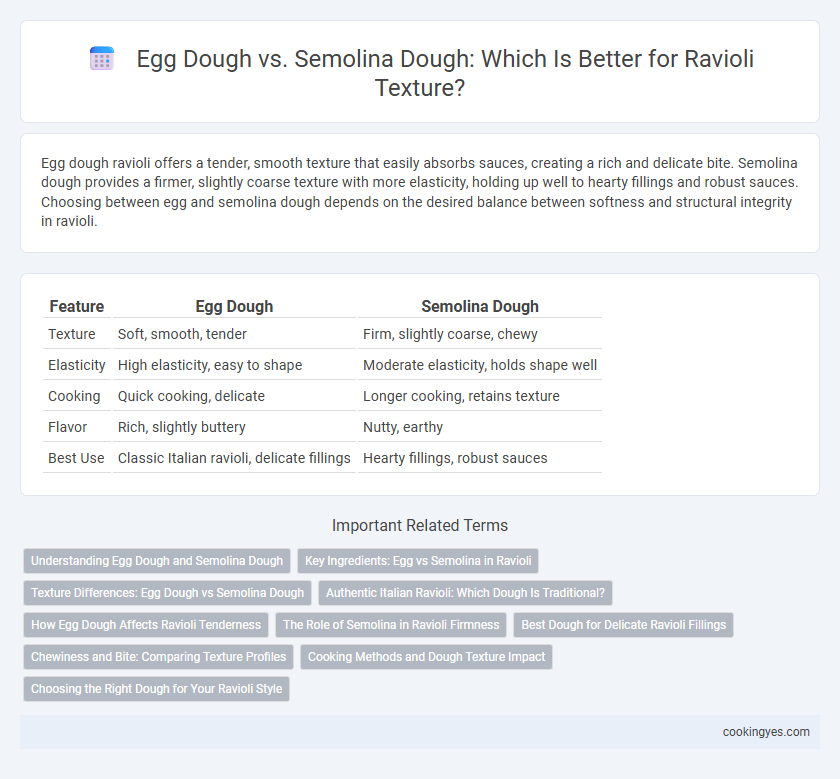Egg dough ravioli offers a tender, smooth texture that easily absorbs sauces, creating a rich and delicate bite. Semolina dough provides a firmer, slightly coarse texture with more elasticity, holding up well to hearty fillings and robust sauces. Choosing between egg and semolina dough depends on the desired balance between softness and structural integrity in ravioli.
Table of Comparison
| Feature | Egg Dough | Semolina Dough |
|---|---|---|
| Texture | Soft, smooth, tender | Firm, slightly coarse, chewy |
| Elasticity | High elasticity, easy to shape | Moderate elasticity, holds shape well |
| Cooking | Quick cooking, delicate | Longer cooking, retains texture |
| Flavor | Rich, slightly buttery | Nutty, earthy |
| Best Use | Classic Italian ravioli, delicate fillings | Hearty fillings, robust sauces |
Understanding Egg Dough and Semolina Dough
Egg dough for ravioli is made with wheat flour and whole eggs, offering a tender, supple texture that holds fillings well and provides a rich flavor. Semolina dough, derived from durum wheat, has a coarser texture and higher protein content, resulting in a firmer, slightly chewy ravioli that maintains its shape during cooking. Understanding the differences in protein and moisture content between egg dough and semolina dough is essential for achieving the desired ravioli texture and mouthfeel.
Key Ingredients: Egg vs Semolina in Ravioli
Egg dough for ravioli offers a rich, tender texture due to its high protein content from eggs, creating a smooth and pliable pasta ideal for delicate fillings. Semolina dough, made from durum wheat, provides a coarser, firmer bite with greater elasticity, enhancing the pasta's ability to hold hearty or moisture-rich fillings without becoming soggy. The choice between egg and semolina dough directly influences ravioli's mouthfeel and structural integrity, tailoring the dish to specific culinary preferences and regional traditions.
Texture Differences: Egg Dough vs Semolina Dough
Egg dough for ravioli creates a tender, silky texture that holds fillings gently while offering a delicate bite, making it ideal for softer or more subtle ingredients. Semolina dough delivers a firmer, slightly coarser texture with more chew, providing robust structure that complements hearty or rustic fillings. Texture differences between egg and semolina dough directly influence the eating experience and best pairing with various ravioli fillings.
Authentic Italian Ravioli: Which Dough Is Traditional?
Authentic Italian ravioli typically use egg dough, made from durum wheat flour and fresh eggs, resulting in a tender, silky texture that complements delicate fillings. Semolina dough, created with coarse semolina flour and water, offers a firmer, slightly chewy bite favored in southern Italy for heartier fillings. The traditional choice varies by region, but egg dough remains the hallmark of classic Italian ravioli with its smooth elasticity and rich flavor profile.
How Egg Dough Affects Ravioli Tenderness
Egg dough enhances ravioli tenderness by incorporating moisture and fat from the eggs, resulting in a softer and more pliable texture compared to semolina dough. The proteins in eggs contribute to a delicate structure that holds fillings gently while maintaining elasticity. This combination ensures each ravioli piece melts smoothly in the mouth, offering a rich, tender bite ideal for delicate sauces.
The Role of Semolina in Ravioli Firmness
Semolina, derived from durum wheat, contributes significantly to ravioli firmness by providing a coarser texture and higher protein content compared to egg dough. This higher protein level in semolina dough creates a stronger gluten network, resulting in a chewier, more resilient pasta shell that holds fillings better during cooking. Texture-wise, semolina dough produces a rustic firmness preferred in traditional Italian ravioli, while egg dough yields a softer, more delicate bite.
Best Dough for Delicate Ravioli Fillings
Egg dough offers a tender and pliable texture that is ideal for delicate ravioli fillings, allowing the pasta to gently encase ingredients without overpowering their flavors. Semolina dough, with its coarser and firmer consistency, provides a slightly chewy bite but can overshadow subtle fillings if not balanced properly. For achieving the best texture that enhances delicate fillings, egg dough remains the preferred choice due to its smooth elasticity and softness.
Chewiness and Bite: Comparing Texture Profiles
Egg dough ravioli offers a supple yet firm texture with a slight chewiness that enhances the pasta's elasticity and bite. Semolina dough, made from coarse durum wheat, provides a denser, more robust bite with a grainier texture, resulting in a chewier mouthfeel. The choice between egg and semolina dough directly affects the ravioli's chewiness and bite, with egg dough delivering a softer chew and semolina dough emphasizing a heartier, more substantial texture.
Cooking Methods and Dough Texture Impact
Egg dough for ravioli provides a tender, smooth texture that holds up well to gentle boiling, creating a delicate yet firm bite. Semolina dough, made from durum wheat, offers a coarser, more resilient texture with a slightly grainy mouthfeel, which performs better under longer cooking times or baking methods without becoming mushy. The choice between egg and semolina dough directly influences the ravioli's cooking time and final texture, with egg dough best suited for quick boiling and semolina dough preferred for durable fillings requiring extended cooking.
Choosing the Right Dough for Your Ravioli Style
Egg dough for ravioli offers a tender, rich texture ideal for delicate fillings like cheese or herbs, providing a smooth mouthfeel that complements subtle flavors. Semolina dough, made from durum wheat, creates a firmer, slightly chewy texture suited for hearty fillings such as meat or vegetables, ensuring the ravioli holds its shape during cooking. Selecting egg dough enhances silkiness, while semolina dough prioritizes durability and a rustic bite, matching your ravioli style to the desired texture and filling type.
Egg dough vs Semolina dough for ravioli texture Infographic

 cookingyes.com
cookingyes.com